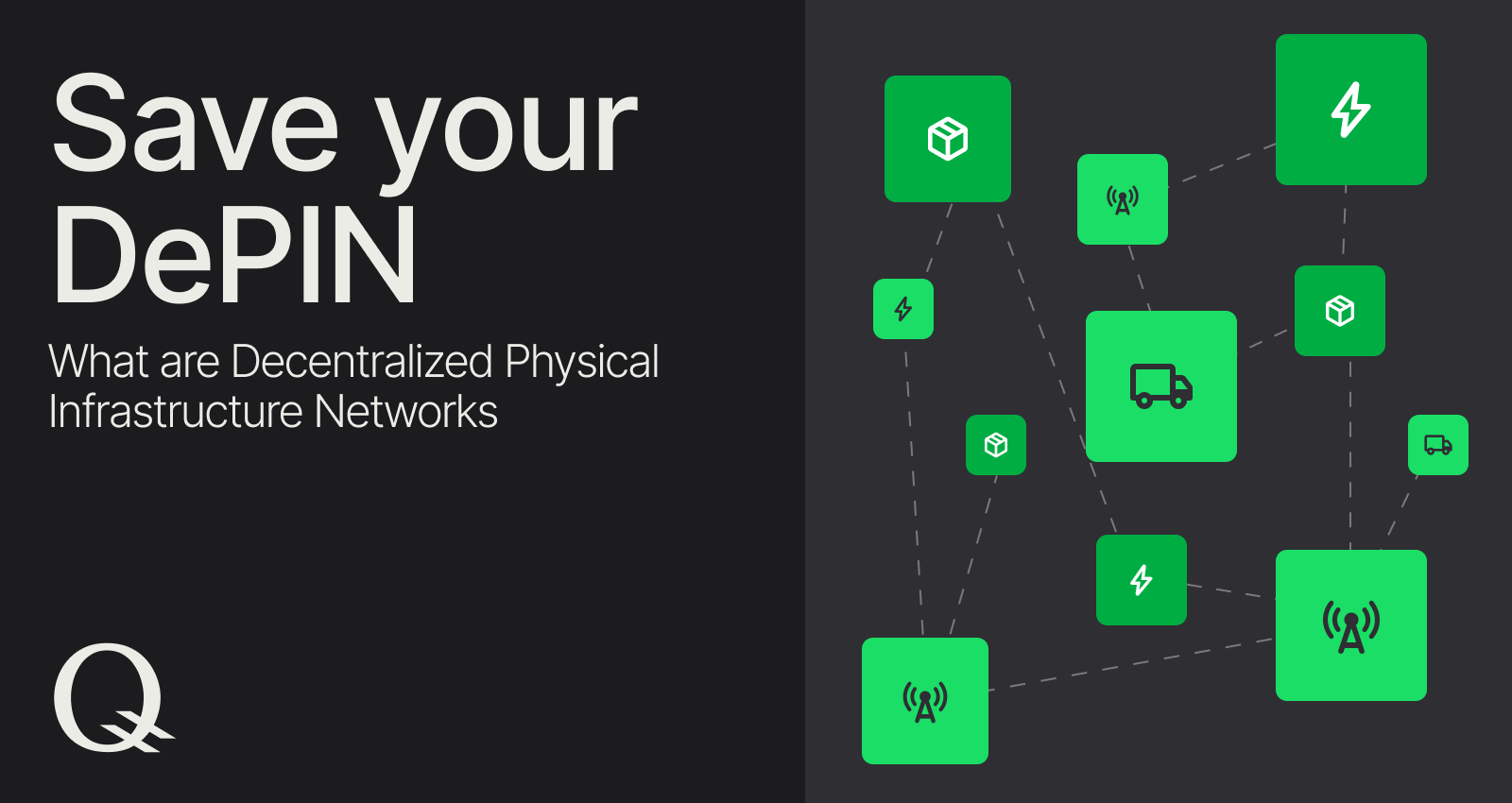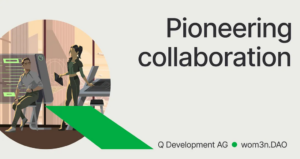There are over 30 billion devices in the world. Imagine all of them being interconnected: communicating with each other, autonomously exchanging information, tasks and payments? Well, it is the future that the Internet of Things (IoT) has been promising us. In fact, it became a step closer with a segment called DePIN in crypto. Let us explain this and other terms, and share our own view on its potential and why reliable governance is required for DePIN to take off.
1. DePIN: A New Buzzword and Same Big Promise
What is DePIN in Crypto?
Decentralized Physical Infrastructure Networks (DePINs) apply blockchain to real-world physical systems, enhancing sectors like energy, telecommunication and supply chains with security, efficiency, and transparency. This novel concept, integrating IoT and smart contracts, democratizes access to resources, enabling concepts like peer-to-peer energy trading and decentralized supply chain tracking.
However, DePINs face regulatory, scalability, and security challenges. Overcoming these through collaborative and innovative governance could revolutionize infrastructure management, making it more resilient, equitable, and sustainable.
Credits: Dr. Andrew Law via X
DePIN in crypto origin
Built for web3, DePINs represent a significant leap towards a decentralized, community-driven approach to physical infrastructure. Originating in 2013, InterPlanetary File System (IPFS) protocol was envisioned to decentralize file storage and Filecoin was planned as an incentive layer. It was the initial DePIN in crypto concept.
Projects like Power Ledger and OpenBazaar further demonstrated the potential of blockchain in decentralizing energy distribution and e-commerce, respectively, paving the way for DePINs to extend into various domains. Furthermore, Helium introduced a decentralized wireless network, while Render offered a decentralized cloud computing platform.
These innovations represent key milestones in the history of DePINs, showcasing their evolution from decentralized file storage to encompassing a wide range of decentralized physical and digital resource networks, connecting blockchain with the real world in unprecedented ways.
How DePIN works?
DePIN integrates physical hardware like hotspots, routers, and energy assets with hardware operators responsible for deployment and maintenance. Decentralized ledger technology and smart contracts ensure transparency and security, while decentralized token incentives motivate participation. End users benefit from operational networks, using crypto assets for real-world services. This synergy of blockchain, smart contracts, and IoT devices redefines infrastructure management, enhancing efficiency and resilience.
Credits: IdeaSoft
Notably, DePINs on blockchain encompass Physical Resource Networks (PRNs) and Digital Resource Networks (DRNs). PRNs involve location-based decentralized physical resource networks, while DRNs entail networks of fungible digital resource providers. These innovations bridge blockchain and the real world in unprecedented ways, ensuring accessibility, integrity, and efficiency for digital assets and data. Like this claim by Bionic DAO that gamers can “play by day and earn by night,” leasing their hardware to AI companies hungry for GPU-power.
Credits: Peaq
2. Exploring DePINs in Crypto: Industries and Project Examples
DePIN Sectors and Trends
The progress of DePIN on blockchain is remarkable. According to a 2024 Messari report, the DePIN ecosystem experienced significant growth in 2023, with over 650 projects emerging across six subsectors: compute (250), AI (200), wireless (100), sensors (50), energy (50), and services (25). The report also highlights that the combined market capitalization of DePINs with liquid tokens exceeded $20 billion, with an estimated annualized on-chain revenue of $15 million.
Examples of DePIN Blockchain projects
Credits: Messari
- Arkreen leverages blockchain technology for green energy initiatives, promoting sustainability in the Web3 ecosystem.
- Arweave offers decentralized file storage through blockchain, akin to projects like Sia, Storj, and Filecoin, providing individuals with the opportunity to contribute spare disk space for storage needs.
- DIMO transforms vehicle data into a monetizable asset for owners, utilizing blockchain technology for secure and transparent data transactions; similarly, Teleport enables rideshare and delivery services for less money, using this data.
- FitFi integrates blockchain into fitness activities, potentially enabling decentralized fitness tracking and incentivizing users for healthy behavior.
- Helium establishes a decentralized IoT network through distributed hotspots, rewarding users for providing connectivity, thus advancing the Web3 infrastructure.
- Hivemapper expands DePIN uses in transport by incentivizing users for capturing street images and contributing to a decentralized mapping network; at the same time, PowerPod promotes a community-based EV charging solution, rewarding charger sharing among drivers.
- Nunet explores blockchain for computing resources, potentially creating a decentralized marketplace for computational power, whereas Render harnesses underutilized GPU power from personal computers, offering a decentralized solution for rendering tasks.
- Power Ledger focuses on enabling peer-to-peer energy transactions, decentralizing power distribution.
- Theta leverages blockchain for decentralized bandwidth provision, optimizing network performance and scalability in the Web3 era.
3. What are the Benefits and Challenges for DePINs?
Benefits of DePIN
DePINs offer decentralized control, enhancing resilience, resource access, and sustainability. They improve system efficiency, promote participation in shared resources, facilitate peer-to-peer transactions, and encourage innovation across industries.
With the rise of interconnectedness and the increasing autonomy of our devices, the potential impact of DePINs becomes even more significant. This exponential growth amplifies the benefits seen in cases such as utilizing idle computers and redistributing excess energy, making the decentralized infrastructure indispensable for fostering a more efficient, sustainable future.
DePIN Challenges
On the other hand, regulatory hurdles, scalability limitations, and security concerns pose significant challenges to the widespread adoption of DePINs, particularly in regulated sectors like telecoms. Interoperability issues and infrastructure requirements further complicate implementation. Constructive dialogue between regulated industries and DePIN projects is essential for progress.
However, despite these challenges, there’s an opportunity to capture a significant portion of economic activity in crypto through innovative solutions like Q Protocol’s “Shared Governance Security.” By providing a decentralized infrastructure for enforcing rules and conditions beyond code, Q Protocol enhances fairness and neutrality, paving the way for broader adoption and real-world impact.
One such example would be compliance with authorities. Let’s say, some of the decentralized mapping network users captured a secure area by accident. On one hand, the user shouldn’t worry, since the decentralized network is censorship resistant by definition. On the other hand, we know the cases when even the users of the most robust blockchain network – Bitcoin – came under scrutiny. Since we envision Q as a legal bridge between the physical and virtual worlds, one of its expert panels could review the case and suggest an outcome that would be a) just to the user; b) fair to the network, and c) cooperative with authorities.
Summary
DePINs promise a decentralized future, bridging the physical world with blockchain technology. However, regulatory hurdles, scalability issues, and security concerns hinder widespread adoption. To address these challenges, innovative governance solutions like Q suggest a path forward. By enforcing rules and conditions beyond code, Q Protocol enhances fairness and neutrality, facilitating broader adoption and real-world impact.






Leave a Reply